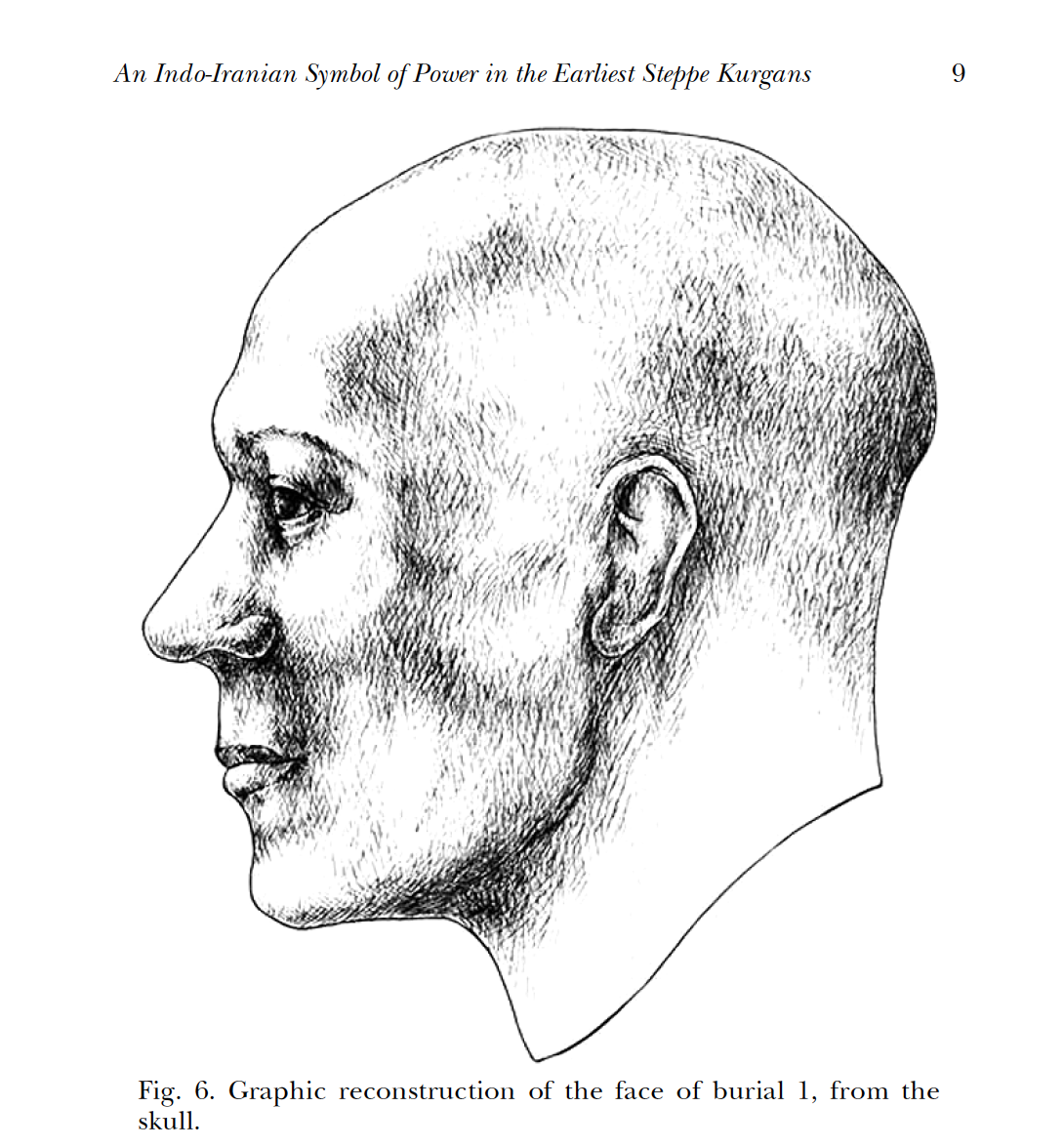https://www.academia.edu/3836804/An_Indo_Iranian_Symbol_of_Power_in_the_Earliest_Steppe_Kurgans
The diameter of kurgan 4 was about 21 meters, and the modern height of the mound is 0.85 m. Central grave 1 was dug into the clay subsoil. The clay taken out of the pit was spread around it in the shape of two platforms. In the center of the northern platform, outside the central grave pit, a secondary accompanying burial was made (Fig. 3) Here a mature female was laid on her back with her knees raised and her head towards the east. Her feet were abundantly powdered by ochre. Her body was covered when the mound was constructed. The principal burial, grave 1, was in a pit measuring 2.8 x 1.7m. It was oriented with its long axis NW-SE. The pit floor was 1.07m beneath the original ground surface. A mature male was laid on his back, originally with his knees half-bent and raised vertically. Later they fell to the right side. The skull was found fallen forward on the chest. The right arm was stretched out along the body; the left was a little bent at the elbow. The body lay across the long axis of the grave, with the head oriented ENE. The facial area of the skull was abundantly painted with red ochre, the pelvis and feet were less painted. A fibrous organic bedding about half a centimeter thick was under the skeleton. The structure of the fibers suggests that the bed was made of either narrow strips of bark fastened together or, more probably, reed mats
Specialist A. Khokhlov of Samara State Pedagogical University determined that the skeleton was of a male 35-40 years old (Fig. 5). His legs were unusually long, especially the lower legs. His forearms also were long. He stood more than 176cm. tall, which is taller than the average height of modern European men. Detailed examination of the joint surfaces of the skeleton led A. Khohlov to the conclusion that the Kutuluk man was unusually active, particularly in walking and/or running.
Calibration of these samples firmly dates the Kutuluk grave to 3100-2800 BC, with the most probable date between 3000 and 2900 BC. The first half of the 3rd millennium BC corresponds well with the dates of other Late Yamnaya culture complexes. A massive copper object was found in the crook of the left arm of the Kutuluk man. It is 48.7cm long overall and weighs 750gms. The handle part is 12.6cm long. The handle is rectangular with polished edges. Some traces indicate that the handle was wrapped with an organic material, probably a leather strap up to 7mm wide. The butt of the handle is semiovoid in plan and broadened in section, giving it extra weight.
Some characteristics of the Vajra.
Among the first to describe the vajra as a cudgel-like weapon was L.S. Klein (Klein 1985: 75). The vajra was tetrahedral (RV 4.22.2]. It had a cow skin-strap (RV 1.121.9). It could be ground (RV 1.55.1). But it had one more very important characteristic—it glistened: All the above-mentioned characteristics of the vajra are most detailed and exact. If we summarize them, we get a description of a weapon used to deliver heavy blows, fracturing and splintering bones, like a cudgel. It had a cow-hide strap. The vajra was made of metal and glistened like gold under the sun, so it must have been made of polished copper or bronze. It was tetrahedal, or four-faced, like the diamond-sectioned Kutuluk cudgel-scepter. Among all the weapon types of Bronze Age, over a period of one and a half thousand years, only the Kutuluk find corresponds to the description of the vajra in the RigVeda. Even the leather strap braiding the handle is rather pertinent in this case.
Similar finds by Falk in the OCP copper hoards.
On the territory of Hindustan in the Ganges-Yamuna Doab are found copper hoards of the 2nd millennium BC, the post-Harappan period. They are connected with the Ochre Colored Pottery culture, which occupied a territory sometimes linked with that of the early Indo-Aryans. Falk noted that the copper hoards included so-called bar-celts, which by their shape and size absolutely coincide with Kutuluk cudgel-scepter. “The vast majority measure about half a meter, and weigh about 1.5kg (Hami, Bihar) or 2.2kg (Gungeria). Therefore I propose to interpret these pieces of copper as clubs, used to kill an adversary either by hitting or by being thrown.” (Falk 1993: 200]. Falk considers the bar-celts to be the material expression of the vajra, the divine weapon of Indra (Falk 1993: 201).
Possible prototypes of the Yamna cudgel?
Prototypes for this specific type of weapon have not been found among earlier Early Bronze Age kurgans, but large antler clubs and polished stone mace-heads of various kinds are wellknown weapons of the Eneolithic period (5000-3500 BC) in the Middle Volga region. These might also have been hurled in battle. They provide earlier examples of weapons that functioned in a way similar to the Kutuluk cudgel-scepter






No comments:
Post a Comment